Analysis of ALDI: Business Environment and Organizational Functions
VerifiedAdded on 2021/01/03
|15
|4766
|18
Report
AI Summary
This report provides a comprehensive analysis of ALDI's business environment, examining its legal structure, objectives, and the interrelation between various organizational functions. It begins with an introduction to business and the business environment, followed by an exploration of different types of organizations, including public, private, multinational, and voluntary entities, with a focus on ALDI, NHS, and Oxfam. The report delves into the size and scope of these organizations, outlining their mission, vision, and objectives. Furthermore, it explores the interrelation between organizational functions such as HR, marketing, production, finance, and R&D, highlighting their contributions to achieving organizational goals. The report also analyzes the positive and negative impacts of the macro-environment on ALDI's operations, alongside an internal and external analysis to identify its strengths and weaknesses, and how these relate to external factors. The report concludes with a summary of the key findings and insights.
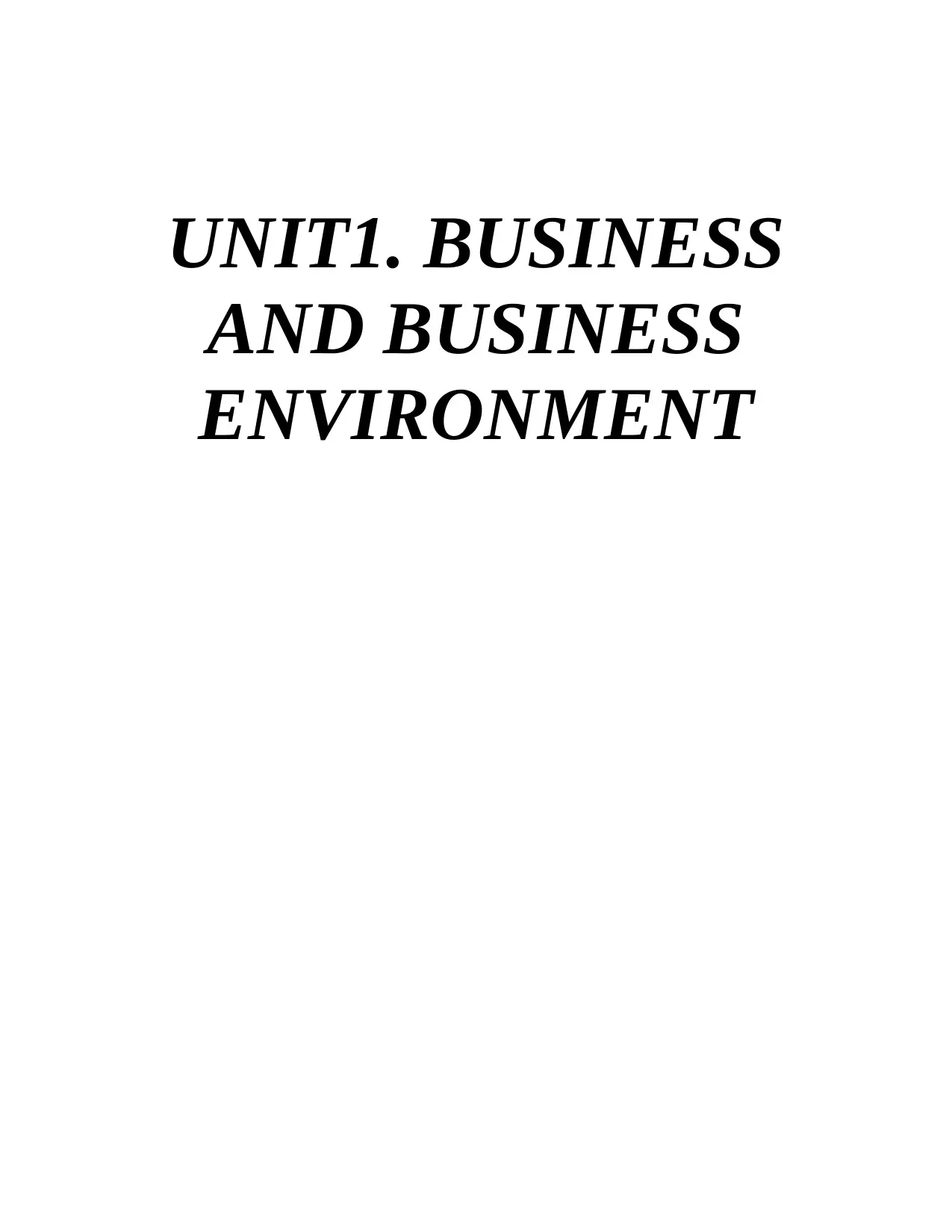
UNIT1. BUSINESS
AND BUSINESS
ENVIRONMENT
AND BUSINESS
ENVIRONMENT
Paraphrase This Document
Need a fresh take? Get an instant paraphrase of this document with our AI Paraphraser
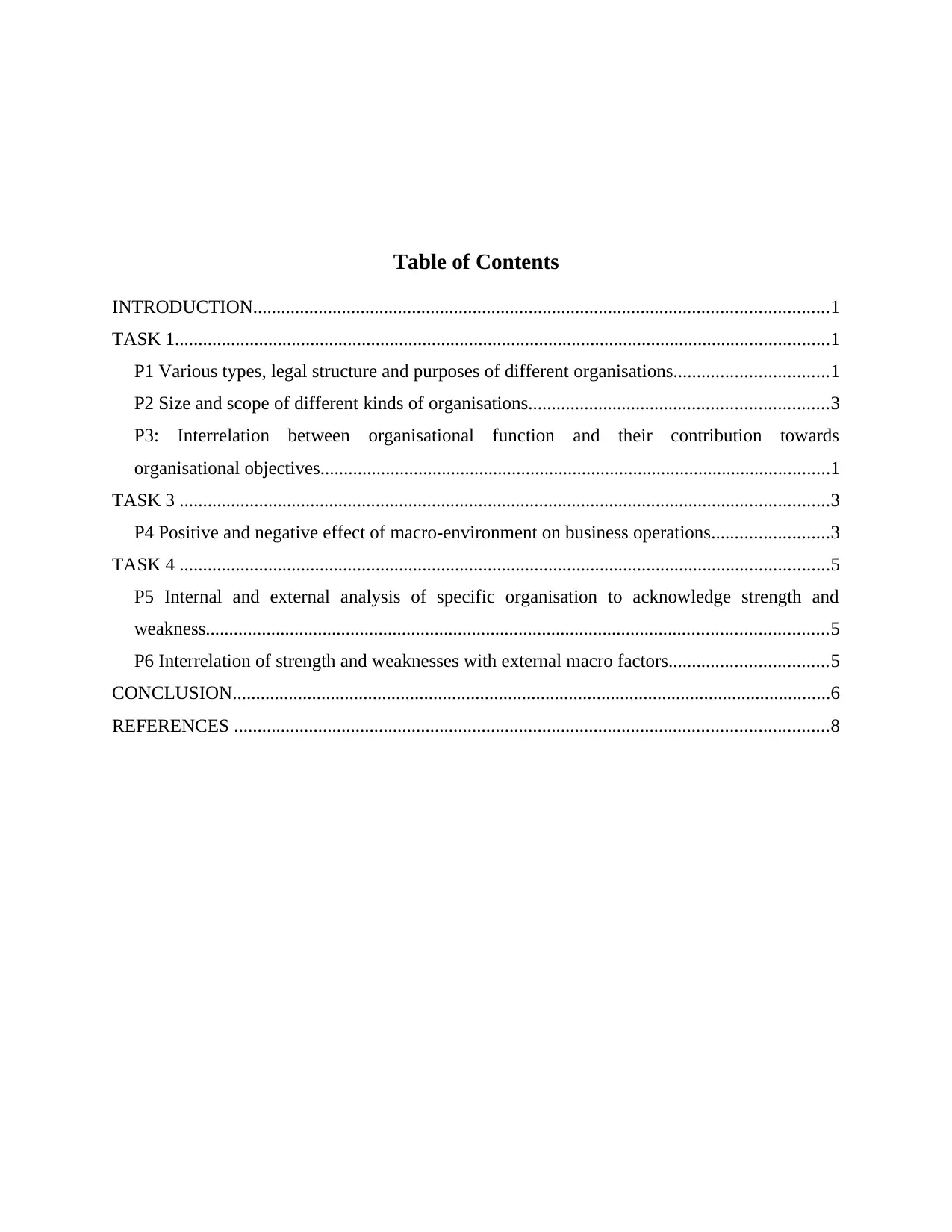
Table of Contents
INTRODUCTION...........................................................................................................................1
TASK 1............................................................................................................................................1
P1 Various types, legal structure and purposes of different organisations.................................1
P2 Size and scope of different kinds of organisations................................................................3
P3: Interrelation between organisational function and their contribution towards
organisational objectives.............................................................................................................1
TASK 3 ...........................................................................................................................................3
P4 Positive and negative effect of macro-environment on business operations.........................3
TASK 4 ...........................................................................................................................................5
P5 Internal and external analysis of specific organisation to acknowledge strength and
weakness.....................................................................................................................................5
P6 Interrelation of strength and weaknesses with external macro factors..................................5
CONCLUSION................................................................................................................................6
REFERENCES ...............................................................................................................................8
INTRODUCTION...........................................................................................................................1
TASK 1............................................................................................................................................1
P1 Various types, legal structure and purposes of different organisations.................................1
P2 Size and scope of different kinds of organisations................................................................3
P3: Interrelation between organisational function and their contribution towards
organisational objectives.............................................................................................................1
TASK 3 ...........................................................................................................................................3
P4 Positive and negative effect of macro-environment on business operations.........................3
TASK 4 ...........................................................................................................................................5
P5 Internal and external analysis of specific organisation to acknowledge strength and
weakness.....................................................................................................................................5
P6 Interrelation of strength and weaknesses with external macro factors..................................5
CONCLUSION................................................................................................................................6
REFERENCES ...............................................................................................................................8
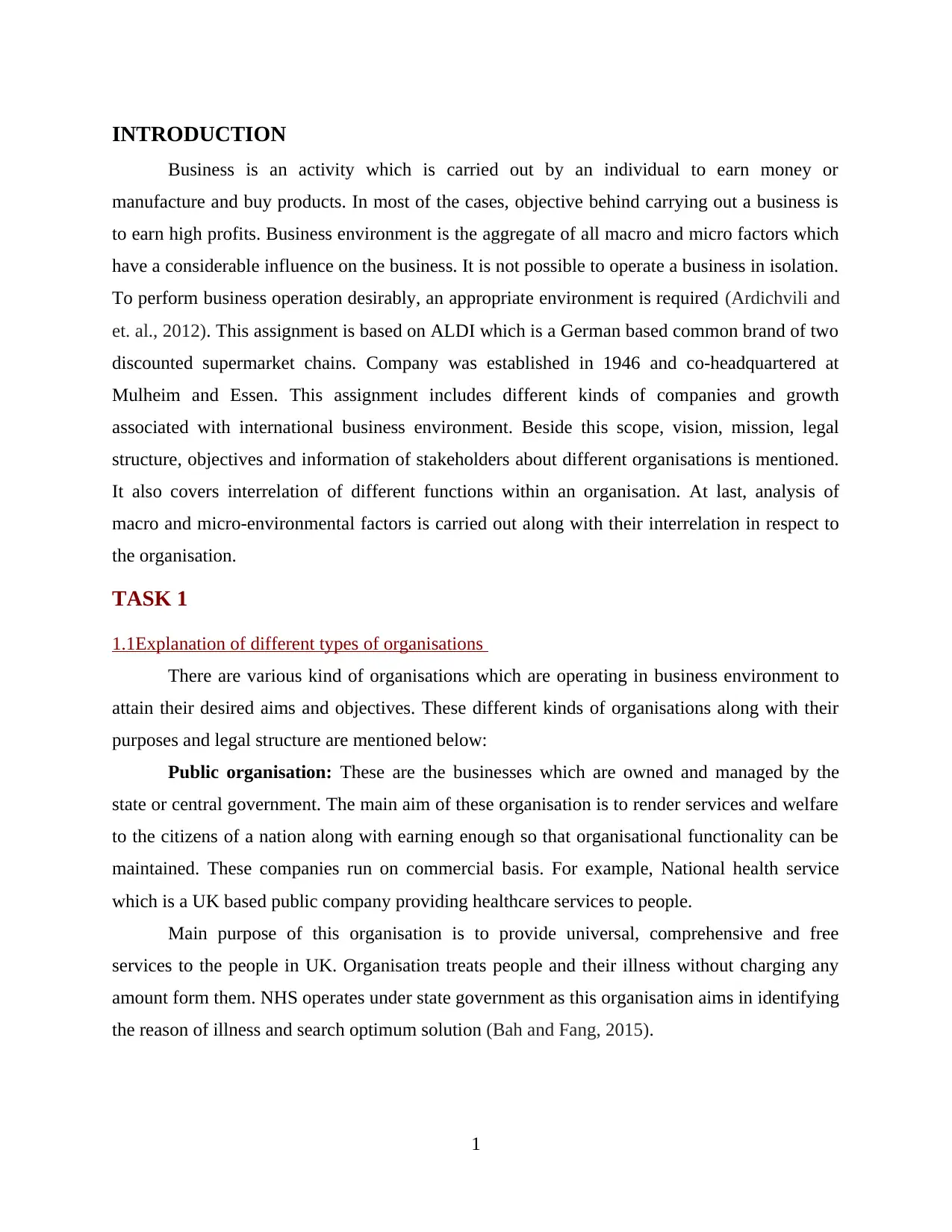
INTRODUCTION
Business is an activity which is carried out by an individual to earn money or
manufacture and buy products. In most of the cases, objective behind carrying out a business is
to earn high profits. Business environment is the aggregate of all macro and micro factors which
have a considerable influence on the business. It is not possible to operate a business in isolation.
To perform business operation desirably, an appropriate environment is required (Ardichvili and
et. al., 2012). This assignment is based on ALDI which is a German based common brand of two
discounted supermarket chains. Company was established in 1946 and co-headquartered at
Mulheim and Essen. This assignment includes different kinds of companies and growth
associated with international business environment. Beside this scope, vision, mission, legal
structure, objectives and information of stakeholders about different organisations is mentioned.
It also covers interrelation of different functions within an organisation. At last, analysis of
macro and micro-environmental factors is carried out along with their interrelation in respect to
the organisation.
TASK 1
1.1Explanation of different types of organisations
There are various kind of organisations which are operating in business environment to
attain their desired aims and objectives. These different kinds of organisations along with their
purposes and legal structure are mentioned below:
Public organisation: These are the businesses which are owned and managed by the
state or central government. The main aim of these organisation is to render services and welfare
to the citizens of a nation along with earning enough so that organisational functionality can be
maintained. These companies run on commercial basis. For example, National health service
which is a UK based public company providing healthcare services to people.
Main purpose of this organisation is to provide universal, comprehensive and free
services to the people in UK. Organisation treats people and their illness without charging any
amount form them. NHS operates under state government as this organisation aims in identifying
the reason of illness and search optimum solution (Bah and Fang, 2015).
1
Business is an activity which is carried out by an individual to earn money or
manufacture and buy products. In most of the cases, objective behind carrying out a business is
to earn high profits. Business environment is the aggregate of all macro and micro factors which
have a considerable influence on the business. It is not possible to operate a business in isolation.
To perform business operation desirably, an appropriate environment is required (Ardichvili and
et. al., 2012). This assignment is based on ALDI which is a German based common brand of two
discounted supermarket chains. Company was established in 1946 and co-headquartered at
Mulheim and Essen. This assignment includes different kinds of companies and growth
associated with international business environment. Beside this scope, vision, mission, legal
structure, objectives and information of stakeholders about different organisations is mentioned.
It also covers interrelation of different functions within an organisation. At last, analysis of
macro and micro-environmental factors is carried out along with their interrelation in respect to
the organisation.
TASK 1
1.1Explanation of different types of organisations
There are various kind of organisations which are operating in business environment to
attain their desired aims and objectives. These different kinds of organisations along with their
purposes and legal structure are mentioned below:
Public organisation: These are the businesses which are owned and managed by the
state or central government. The main aim of these organisation is to render services and welfare
to the citizens of a nation along with earning enough so that organisational functionality can be
maintained. These companies run on commercial basis. For example, National health service
which is a UK based public company providing healthcare services to people.
Main purpose of this organisation is to provide universal, comprehensive and free
services to the people in UK. Organisation treats people and their illness without charging any
amount form them. NHS operates under state government as this organisation aims in identifying
the reason of illness and search optimum solution (Bah and Fang, 2015).
1
⊘ This is a preview!⊘
Do you want full access?
Subscribe today to unlock all pages.

Trusted by 1+ million students worldwide
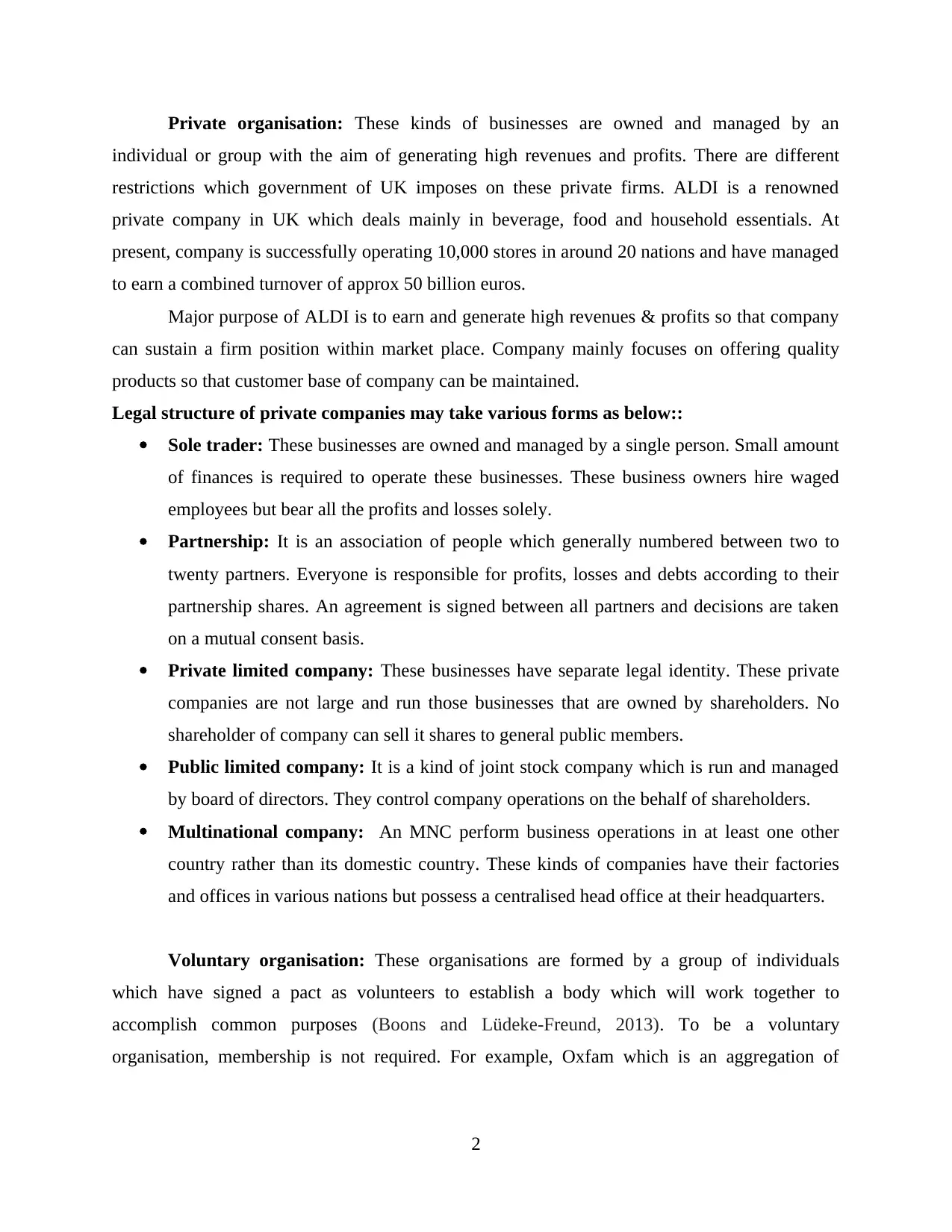
Private organisation: These kinds of businesses are owned and managed by an
individual or group with the aim of generating high revenues and profits. There are different
restrictions which government of UK imposes on these private firms. ALDI is a renowned
private company in UK which deals mainly in beverage, food and household essentials. At
present, company is successfully operating 10,000 stores in around 20 nations and have managed
to earn a combined turnover of approx 50 billion euros.
Major purpose of ALDI is to earn and generate high revenues & profits so that company
can sustain a firm position within market place. Company mainly focuses on offering quality
products so that customer base of company can be maintained.
Legal structure of private companies may take various forms as below::
Sole trader: These businesses are owned and managed by a single person. Small amount
of finances is required to operate these businesses. These business owners hire waged
employees but bear all the profits and losses solely.
Partnership: It is an association of people which generally numbered between two to
twenty partners. Everyone is responsible for profits, losses and debts according to their
partnership shares. An agreement is signed between all partners and decisions are taken
on a mutual consent basis.
Private limited company: These businesses have separate legal identity. These private
companies are not large and run those businesses that are owned by shareholders. No
shareholder of company can sell it shares to general public members.
Public limited company: It is a kind of joint stock company which is run and managed
by board of directors. They control company operations on the behalf of shareholders.
Multinational company: An MNC perform business operations in at least one other
country rather than its domestic country. These kinds of companies have their factories
and offices in various nations but possess a centralised head office at their headquarters.
Voluntary organisation: These organisations are formed by a group of individuals
which have signed a pact as volunteers to establish a body which will work together to
accomplish common purposes (Boons and Lüdeke-Freund, 2013). To be a voluntary
organisation, membership is not required. For example, Oxfam which is an aggregation of
2
individual or group with the aim of generating high revenues and profits. There are different
restrictions which government of UK imposes on these private firms. ALDI is a renowned
private company in UK which deals mainly in beverage, food and household essentials. At
present, company is successfully operating 10,000 stores in around 20 nations and have managed
to earn a combined turnover of approx 50 billion euros.
Major purpose of ALDI is to earn and generate high revenues & profits so that company
can sustain a firm position within market place. Company mainly focuses on offering quality
products so that customer base of company can be maintained.
Legal structure of private companies may take various forms as below::
Sole trader: These businesses are owned and managed by a single person. Small amount
of finances is required to operate these businesses. These business owners hire waged
employees but bear all the profits and losses solely.
Partnership: It is an association of people which generally numbered between two to
twenty partners. Everyone is responsible for profits, losses and debts according to their
partnership shares. An agreement is signed between all partners and decisions are taken
on a mutual consent basis.
Private limited company: These businesses have separate legal identity. These private
companies are not large and run those businesses that are owned by shareholders. No
shareholder of company can sell it shares to general public members.
Public limited company: It is a kind of joint stock company which is run and managed
by board of directors. They control company operations on the behalf of shareholders.
Multinational company: An MNC perform business operations in at least one other
country rather than its domestic country. These kinds of companies have their factories
and offices in various nations but possess a centralised head office at their headquarters.
Voluntary organisation: These organisations are formed by a group of individuals
which have signed a pact as volunteers to establish a body which will work together to
accomplish common purposes (Boons and Lüdeke-Freund, 2013). To be a voluntary
organisation, membership is not required. For example, Oxfam which is an aggregation of
2
Paraphrase This Document
Need a fresh take? Get an instant paraphrase of this document with our AI Paraphraser
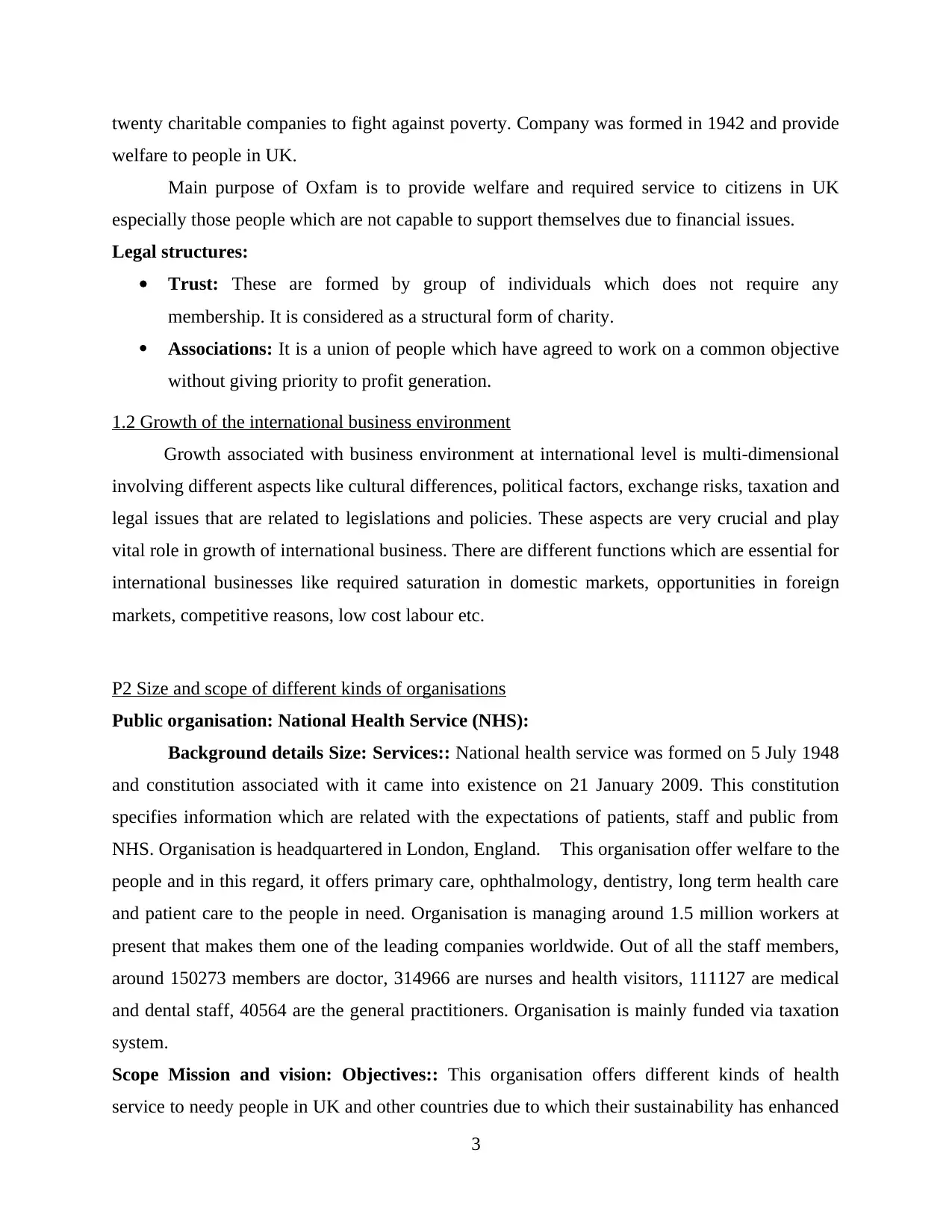
twenty charitable companies to fight against poverty. Company was formed in 1942 and provide
welfare to people in UK.
Main purpose of Oxfam is to provide welfare and required service to citizens in UK
especially those people which are not capable to support themselves due to financial issues.
Legal structures:
Trust: These are formed by group of individuals which does not require any
membership. It is considered as a structural form of charity.
Associations: It is a union of people which have agreed to work on a common objective
without giving priority to profit generation.
1.2 Growth of the international business environment
Growth associated with business environment at international level is multi-dimensional
involving different aspects like cultural differences, political factors, exchange risks, taxation and
legal issues that are related to legislations and policies. These aspects are very crucial and play
vital role in growth of international business. There are different functions which are essential for
international businesses like required saturation in domestic markets, opportunities in foreign
markets, competitive reasons, low cost labour etc.
P2 Size and scope of different kinds of organisations
Public organisation: National Health Service (NHS):
Background details Size: Services:: National health service was formed on 5 July 1948
and constitution associated with it came into existence on 21 January 2009. This constitution
specifies information which are related with the expectations of patients, staff and public from
NHS. Organisation is headquartered in London, England. This organisation offer welfare to the
people and in this regard, it offers primary care, ophthalmology, dentistry, long term health care
and patient care to the people in need. Organisation is managing around 1.5 million workers at
present that makes them one of the leading companies worldwide. Out of all the staff members,
around 150273 members are doctor, 314966 are nurses and health visitors, 111127 are medical
and dental staff, 40564 are the general practitioners. Organisation is mainly funded via taxation
system.
Scope Mission and vision: Objectives:: This organisation offers different kinds of health
service to needy people in UK and other countries due to which their sustainability has enhanced
3
welfare to people in UK.
Main purpose of Oxfam is to provide welfare and required service to citizens in UK
especially those people which are not capable to support themselves due to financial issues.
Legal structures:
Trust: These are formed by group of individuals which does not require any
membership. It is considered as a structural form of charity.
Associations: It is a union of people which have agreed to work on a common objective
without giving priority to profit generation.
1.2 Growth of the international business environment
Growth associated with business environment at international level is multi-dimensional
involving different aspects like cultural differences, political factors, exchange risks, taxation and
legal issues that are related to legislations and policies. These aspects are very crucial and play
vital role in growth of international business. There are different functions which are essential for
international businesses like required saturation in domestic markets, opportunities in foreign
markets, competitive reasons, low cost labour etc.
P2 Size and scope of different kinds of organisations
Public organisation: National Health Service (NHS):
Background details Size: Services:: National health service was formed on 5 July 1948
and constitution associated with it came into existence on 21 January 2009. This constitution
specifies information which are related with the expectations of patients, staff and public from
NHS. Organisation is headquartered in London, England. This organisation offer welfare to the
people and in this regard, it offers primary care, ophthalmology, dentistry, long term health care
and patient care to the people in need. Organisation is managing around 1.5 million workers at
present that makes them one of the leading companies worldwide. Out of all the staff members,
around 150273 members are doctor, 314966 are nurses and health visitors, 111127 are medical
and dental staff, 40564 are the general practitioners. Organisation is mainly funded via taxation
system.
Scope Mission and vision: Objectives:: This organisation offers different kinds of health
service to needy people in UK and other countries due to which their sustainability has enhanced
3
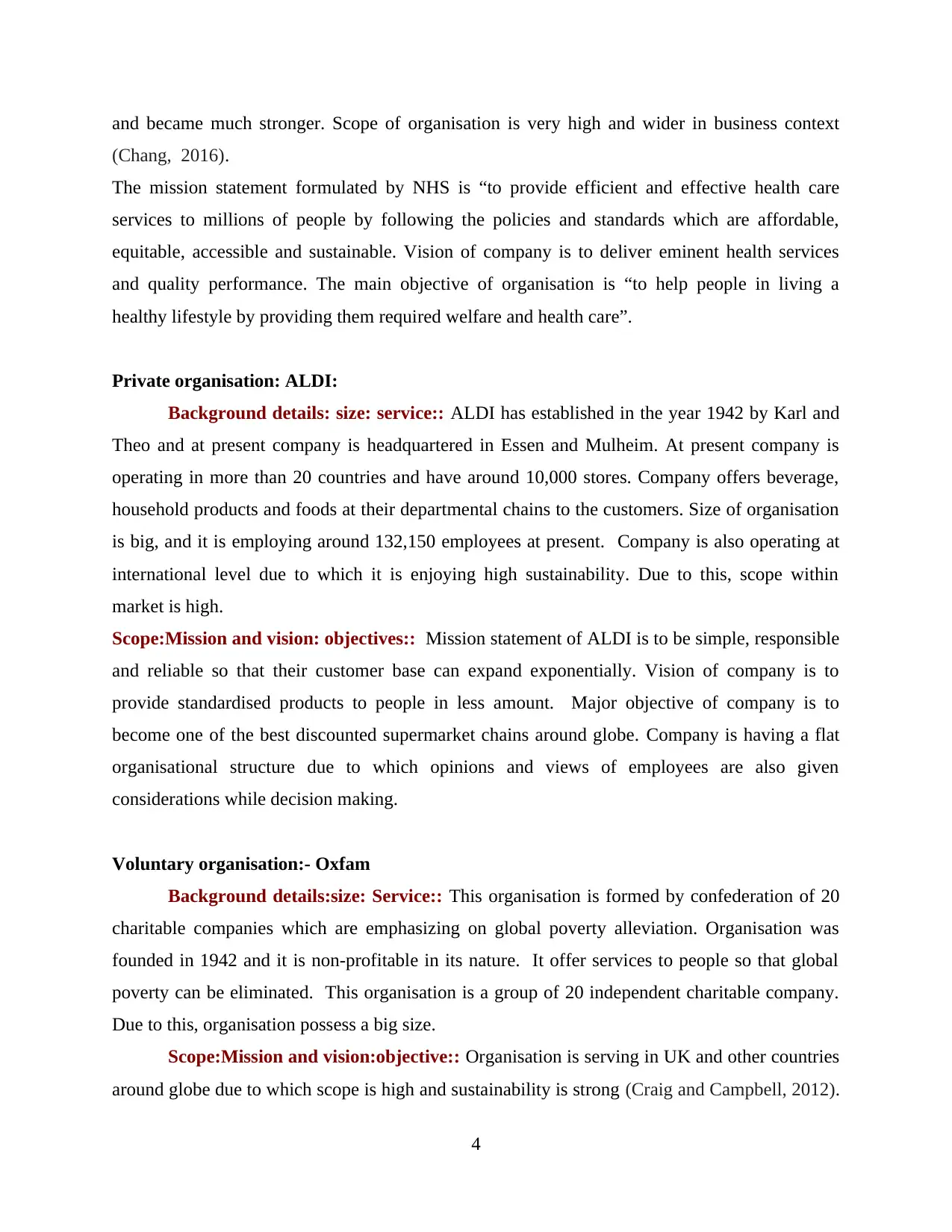
and became much stronger. Scope of organisation is very high and wider in business context
(Chang, 2016).
The mission statement formulated by NHS is “to provide efficient and effective health care
services to millions of people by following the policies and standards which are affordable,
equitable, accessible and sustainable. Vision of company is to deliver eminent health services
and quality performance. The main objective of organisation is “to help people in living a
healthy lifestyle by providing them required welfare and health care”.
Private organisation: ALDI:
Background details: size: service:: ALDI has established in the year 1942 by Karl and
Theo and at present company is headquartered in Essen and Mulheim. At present company is
operating in more than 20 countries and have around 10,000 stores. Company offers beverage,
household products and foods at their departmental chains to the customers. Size of organisation
is big, and it is employing around 132,150 employees at present. Company is also operating at
international level due to which it is enjoying high sustainability. Due to this, scope within
market is high.
Scope:Mission and vision: objectives:: Mission statement of ALDI is to be simple, responsible
and reliable so that their customer base can expand exponentially. Vision of company is to
provide standardised products to people in less amount. Major objective of company is to
become one of the best discounted supermarket chains around globe. Company is having a flat
organisational structure due to which opinions and views of employees are also given
considerations while decision making.
Voluntary organisation:- Oxfam
Background details:size: Service:: This organisation is formed by confederation of 20
charitable companies which are emphasizing on global poverty alleviation. Organisation was
founded in 1942 and it is non-profitable in its nature. It offer services to people so that global
poverty can be eliminated. This organisation is a group of 20 independent charitable company.
Due to this, organisation possess a big size.
Scope:Mission and vision:objective:: Organisation is serving in UK and other countries
around globe due to which scope is high and sustainability is strong (Craig and Campbell, 2012).
4
(Chang, 2016).
The mission statement formulated by NHS is “to provide efficient and effective health care
services to millions of people by following the policies and standards which are affordable,
equitable, accessible and sustainable. Vision of company is to deliver eminent health services
and quality performance. The main objective of organisation is “to help people in living a
healthy lifestyle by providing them required welfare and health care”.
Private organisation: ALDI:
Background details: size: service:: ALDI has established in the year 1942 by Karl and
Theo and at present company is headquartered in Essen and Mulheim. At present company is
operating in more than 20 countries and have around 10,000 stores. Company offers beverage,
household products and foods at their departmental chains to the customers. Size of organisation
is big, and it is employing around 132,150 employees at present. Company is also operating at
international level due to which it is enjoying high sustainability. Due to this, scope within
market is high.
Scope:Mission and vision: objectives:: Mission statement of ALDI is to be simple, responsible
and reliable so that their customer base can expand exponentially. Vision of company is to
provide standardised products to people in less amount. Major objective of company is to
become one of the best discounted supermarket chains around globe. Company is having a flat
organisational structure due to which opinions and views of employees are also given
considerations while decision making.
Voluntary organisation:- Oxfam
Background details:size: Service:: This organisation is formed by confederation of 20
charitable companies which are emphasizing on global poverty alleviation. Organisation was
founded in 1942 and it is non-profitable in its nature. It offer services to people so that global
poverty can be eliminated. This organisation is a group of 20 independent charitable company.
Due to this, organisation possess a big size.
Scope:Mission and vision:objective:: Organisation is serving in UK and other countries
around globe due to which scope is high and sustainability is strong (Craig and Campbell, 2012).
4
⊘ This is a preview!⊘
Do you want full access?
Subscribe today to unlock all pages.

Trusted by 1+ million students worldwide
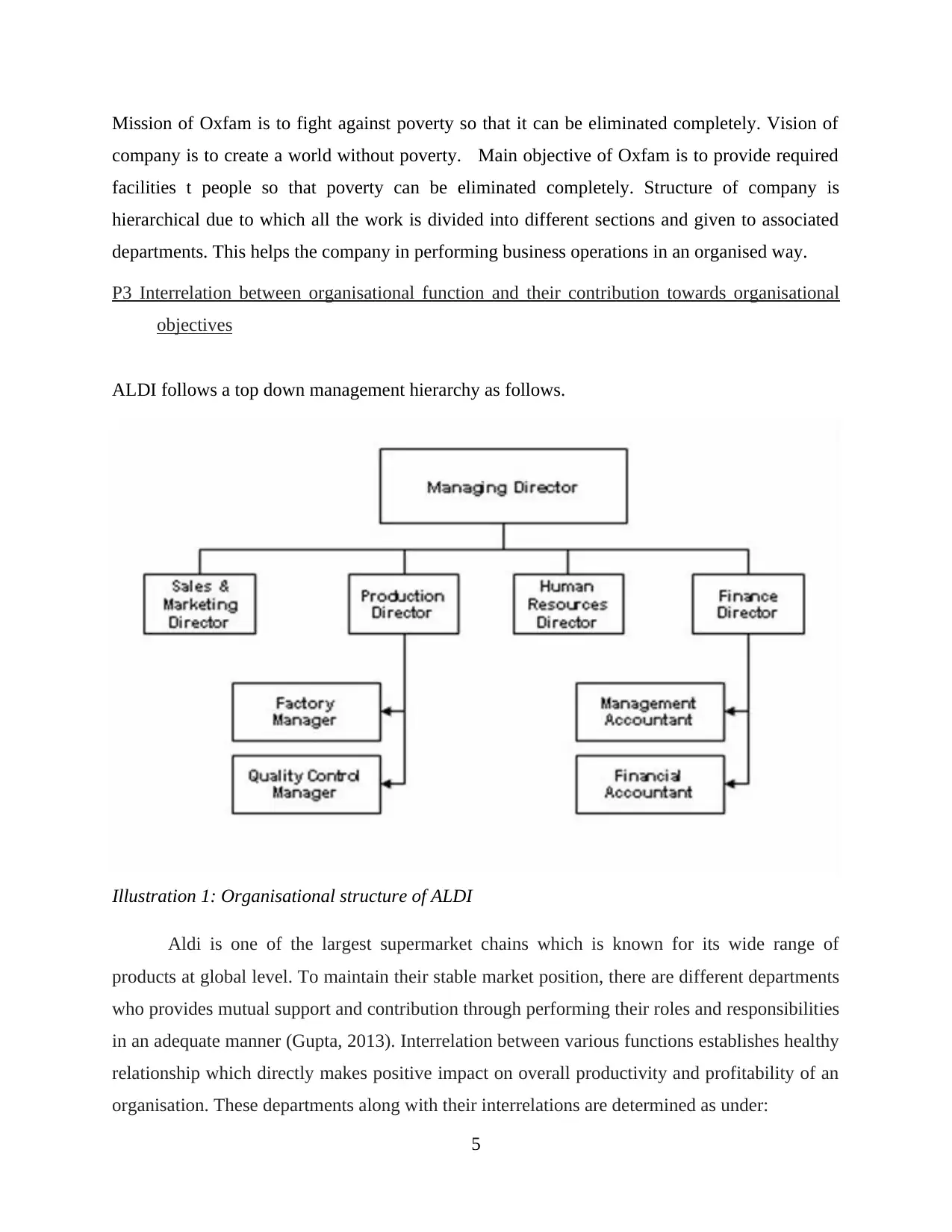
Mission of Oxfam is to fight against poverty so that it can be eliminated completely. Vision of
company is to create a world without poverty. Main objective of Oxfam is to provide required
facilities t people so that poverty can be eliminated completely. Structure of company is
hierarchical due to which all the work is divided into different sections and given to associated
departments. This helps the company in performing business operations in an organised way.
P3 Interrelation between organisational function and their contribution towards organisational
objectives
ALDI follows a top down management hierarchy as follows.
Illustration 1: Organisational structure of ALDI
Aldi is one of the largest supermarket chains which is known for its wide range of
products at global level. To maintain their stable market position, there are different departments
who provides mutual support and contribution through performing their roles and responsibilities
in an adequate manner (Gupta, 2013). Interrelation between various functions establishes healthy
relationship which directly makes positive impact on overall productivity and profitability of an
organisation. These departments along with their interrelations are determined as under:
5
company is to create a world without poverty. Main objective of Oxfam is to provide required
facilities t people so that poverty can be eliminated completely. Structure of company is
hierarchical due to which all the work is divided into different sections and given to associated
departments. This helps the company in performing business operations in an organised way.
P3 Interrelation between organisational function and their contribution towards organisational
objectives
ALDI follows a top down management hierarchy as follows.
Illustration 1: Organisational structure of ALDI
Aldi is one of the largest supermarket chains which is known for its wide range of
products at global level. To maintain their stable market position, there are different departments
who provides mutual support and contribution through performing their roles and responsibilities
in an adequate manner (Gupta, 2013). Interrelation between various functions establishes healthy
relationship which directly makes positive impact on overall productivity and profitability of an
organisation. These departments along with their interrelations are determined as under:
5
Paraphrase This Document
Need a fresh take? Get an instant paraphrase of this document with our AI Paraphraser
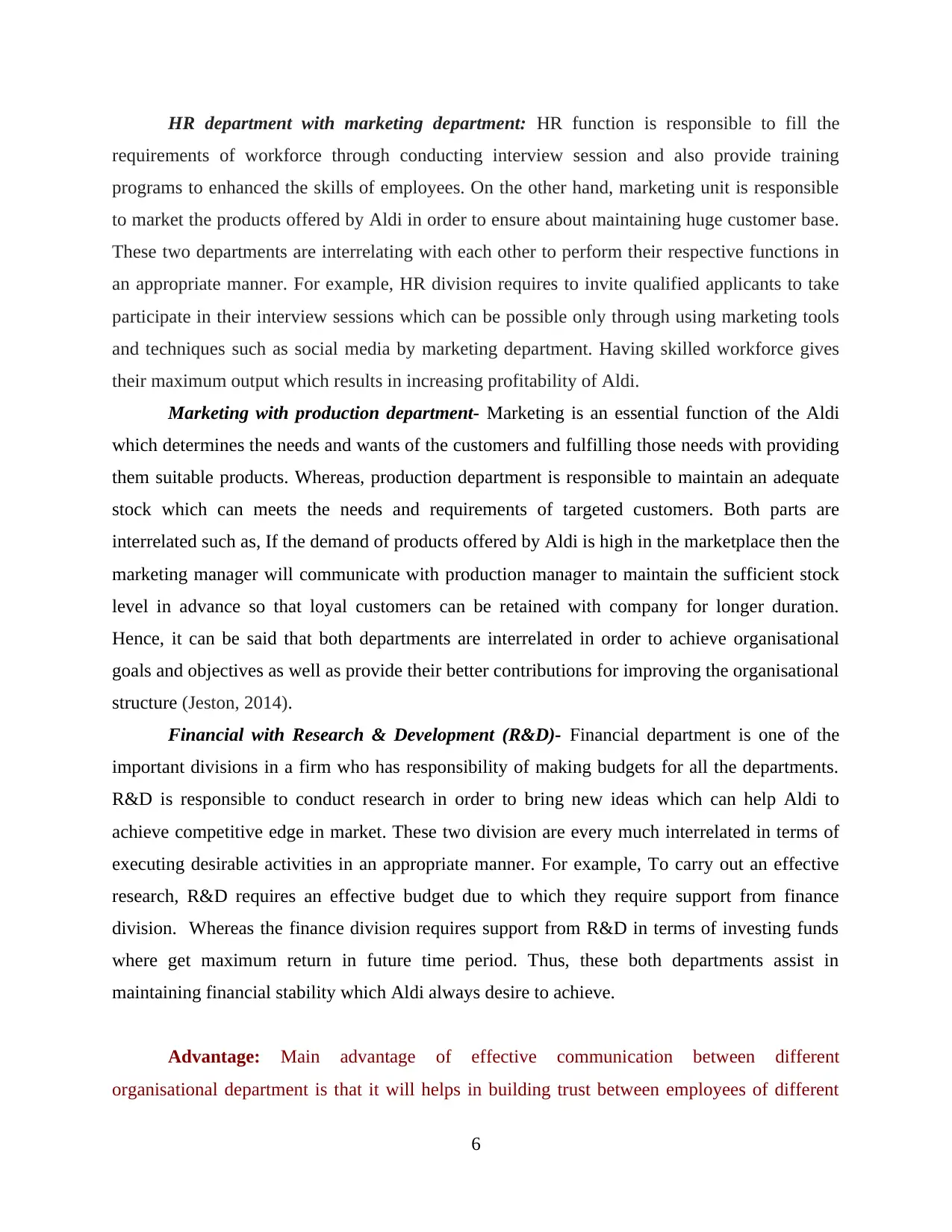
HR department with marketing department: HR function is responsible to fill the
requirements of workforce through conducting interview session and also provide training
programs to enhanced the skills of employees. On the other hand, marketing unit is responsible
to market the products offered by Aldi in order to ensure about maintaining huge customer base.
These two departments are interrelating with each other to perform their respective functions in
an appropriate manner. For example, HR division requires to invite qualified applicants to take
participate in their interview sessions which can be possible only through using marketing tools
and techniques such as social media by marketing department. Having skilled workforce gives
their maximum output which results in increasing profitability of Aldi.
Marketing with production department- Marketing is an essential function of the Aldi
which determines the needs and wants of the customers and fulfilling those needs with providing
them suitable products. Whereas, production department is responsible to maintain an adequate
stock which can meets the needs and requirements of targeted customers. Both parts are
interrelated such as, If the demand of products offered by Aldi is high in the marketplace then the
marketing manager will communicate with production manager to maintain the sufficient stock
level in advance so that loyal customers can be retained with company for longer duration.
Hence, it can be said that both departments are interrelated in order to achieve organisational
goals and objectives as well as provide their better contributions for improving the organisational
structure (Jeston, 2014).
Financial with Research & Development (R&D)- Financial department is one of the
important divisions in a firm who has responsibility of making budgets for all the departments.
R&D is responsible to conduct research in order to bring new ideas which can help Aldi to
achieve competitive edge in market. These two division are every much interrelated in terms of
executing desirable activities in an appropriate manner. For example, To carry out an effective
research, R&D requires an effective budget due to which they require support from finance
division. Whereas the finance division requires support from R&D in terms of investing funds
where get maximum return in future time period. Thus, these both departments assist in
maintaining financial stability which Aldi always desire to achieve.
Advantage: Main advantage of effective communication between different
organisational department is that it will helps in building trust between employees of different
6
requirements of workforce through conducting interview session and also provide training
programs to enhanced the skills of employees. On the other hand, marketing unit is responsible
to market the products offered by Aldi in order to ensure about maintaining huge customer base.
These two departments are interrelating with each other to perform their respective functions in
an appropriate manner. For example, HR division requires to invite qualified applicants to take
participate in their interview sessions which can be possible only through using marketing tools
and techniques such as social media by marketing department. Having skilled workforce gives
their maximum output which results in increasing profitability of Aldi.
Marketing with production department- Marketing is an essential function of the Aldi
which determines the needs and wants of the customers and fulfilling those needs with providing
them suitable products. Whereas, production department is responsible to maintain an adequate
stock which can meets the needs and requirements of targeted customers. Both parts are
interrelated such as, If the demand of products offered by Aldi is high in the marketplace then the
marketing manager will communicate with production manager to maintain the sufficient stock
level in advance so that loyal customers can be retained with company for longer duration.
Hence, it can be said that both departments are interrelated in order to achieve organisational
goals and objectives as well as provide their better contributions for improving the organisational
structure (Jeston, 2014).
Financial with Research & Development (R&D)- Financial department is one of the
important divisions in a firm who has responsibility of making budgets for all the departments.
R&D is responsible to conduct research in order to bring new ideas which can help Aldi to
achieve competitive edge in market. These two division are every much interrelated in terms of
executing desirable activities in an appropriate manner. For example, To carry out an effective
research, R&D requires an effective budget due to which they require support from finance
division. Whereas the finance division requires support from R&D in terms of investing funds
where get maximum return in future time period. Thus, these both departments assist in
maintaining financial stability which Aldi always desire to achieve.
Advantage: Main advantage of effective communication between different
organisational department is that it will helps in building trust between employees of different
6
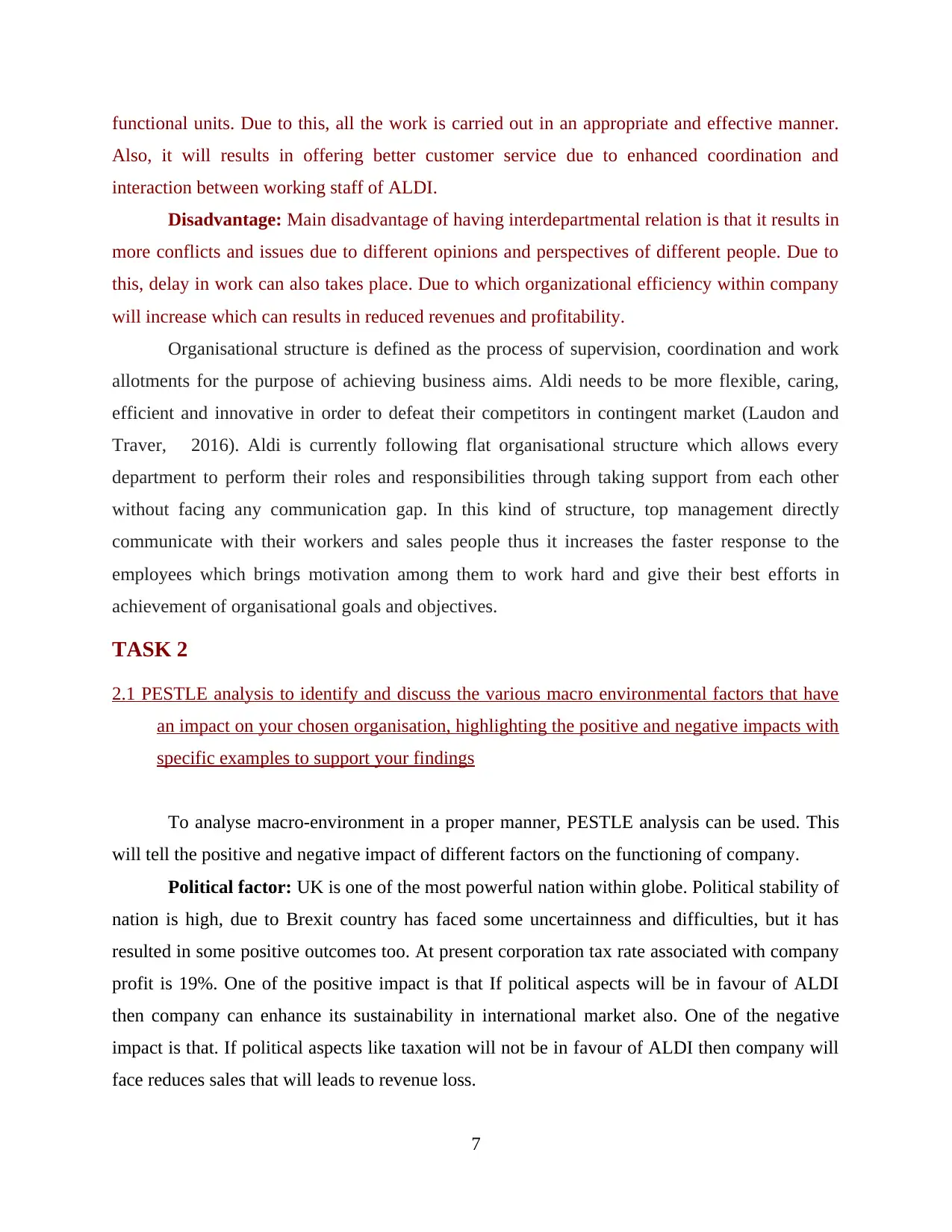
functional units. Due to this, all the work is carried out in an appropriate and effective manner.
Also, it will results in offering better customer service due to enhanced coordination and
interaction between working staff of ALDI.
Disadvantage: Main disadvantage of having interdepartmental relation is that it results in
more conflicts and issues due to different opinions and perspectives of different people. Due to
this, delay in work can also takes place. Due to which organizational efficiency within company
will increase which can results in reduced revenues and profitability.
Organisational structure is defined as the process of supervision, coordination and work
allotments for the purpose of achieving business aims. Aldi needs to be more flexible, caring,
efficient and innovative in order to defeat their competitors in contingent market (Laudon and
Traver, 2016). Aldi is currently following flat organisational structure which allows every
department to perform their roles and responsibilities through taking support from each other
without facing any communication gap. In this kind of structure, top management directly
communicate with their workers and sales people thus it increases the faster response to the
employees which brings motivation among them to work hard and give their best efforts in
achievement of organisational goals and objectives.
TASK 2
2.1 PESTLE analysis to identify and discuss the various macro environmental factors that have
an impact on your chosen organisation, highlighting the positive and negative impacts with
specific examples to support your findings
To analyse macro-environment in a proper manner, PESTLE analysis can be used. This
will tell the positive and negative impact of different factors on the functioning of company.
Political factor: UK is one of the most powerful nation within globe. Political stability of
nation is high, due to Brexit country has faced some uncertainness and difficulties, but it has
resulted in some positive outcomes too. At present corporation tax rate associated with company
profit is 19%. One of the positive impact is that If political aspects will be in favour of ALDI
then company can enhance its sustainability in international market also. One of the negative
impact is that. If political aspects like taxation will not be in favour of ALDI then company will
face reduces sales that will leads to revenue loss.
7
Also, it will results in offering better customer service due to enhanced coordination and
interaction between working staff of ALDI.
Disadvantage: Main disadvantage of having interdepartmental relation is that it results in
more conflicts and issues due to different opinions and perspectives of different people. Due to
this, delay in work can also takes place. Due to which organizational efficiency within company
will increase which can results in reduced revenues and profitability.
Organisational structure is defined as the process of supervision, coordination and work
allotments for the purpose of achieving business aims. Aldi needs to be more flexible, caring,
efficient and innovative in order to defeat their competitors in contingent market (Laudon and
Traver, 2016). Aldi is currently following flat organisational structure which allows every
department to perform their roles and responsibilities through taking support from each other
without facing any communication gap. In this kind of structure, top management directly
communicate with their workers and sales people thus it increases the faster response to the
employees which brings motivation among them to work hard and give their best efforts in
achievement of organisational goals and objectives.
TASK 2
2.1 PESTLE analysis to identify and discuss the various macro environmental factors that have
an impact on your chosen organisation, highlighting the positive and negative impacts with
specific examples to support your findings
To analyse macro-environment in a proper manner, PESTLE analysis can be used. This
will tell the positive and negative impact of different factors on the functioning of company.
Political factor: UK is one of the most powerful nation within globe. Political stability of
nation is high, due to Brexit country has faced some uncertainness and difficulties, but it has
resulted in some positive outcomes too. At present corporation tax rate associated with company
profit is 19%. One of the positive impact is that If political aspects will be in favour of ALDI
then company can enhance its sustainability in international market also. One of the negative
impact is that. If political aspects like taxation will not be in favour of ALDI then company will
face reduces sales that will leads to revenue loss.
7
⊘ This is a preview!⊘
Do you want full access?
Subscribe today to unlock all pages.

Trusted by 1+ million students worldwide
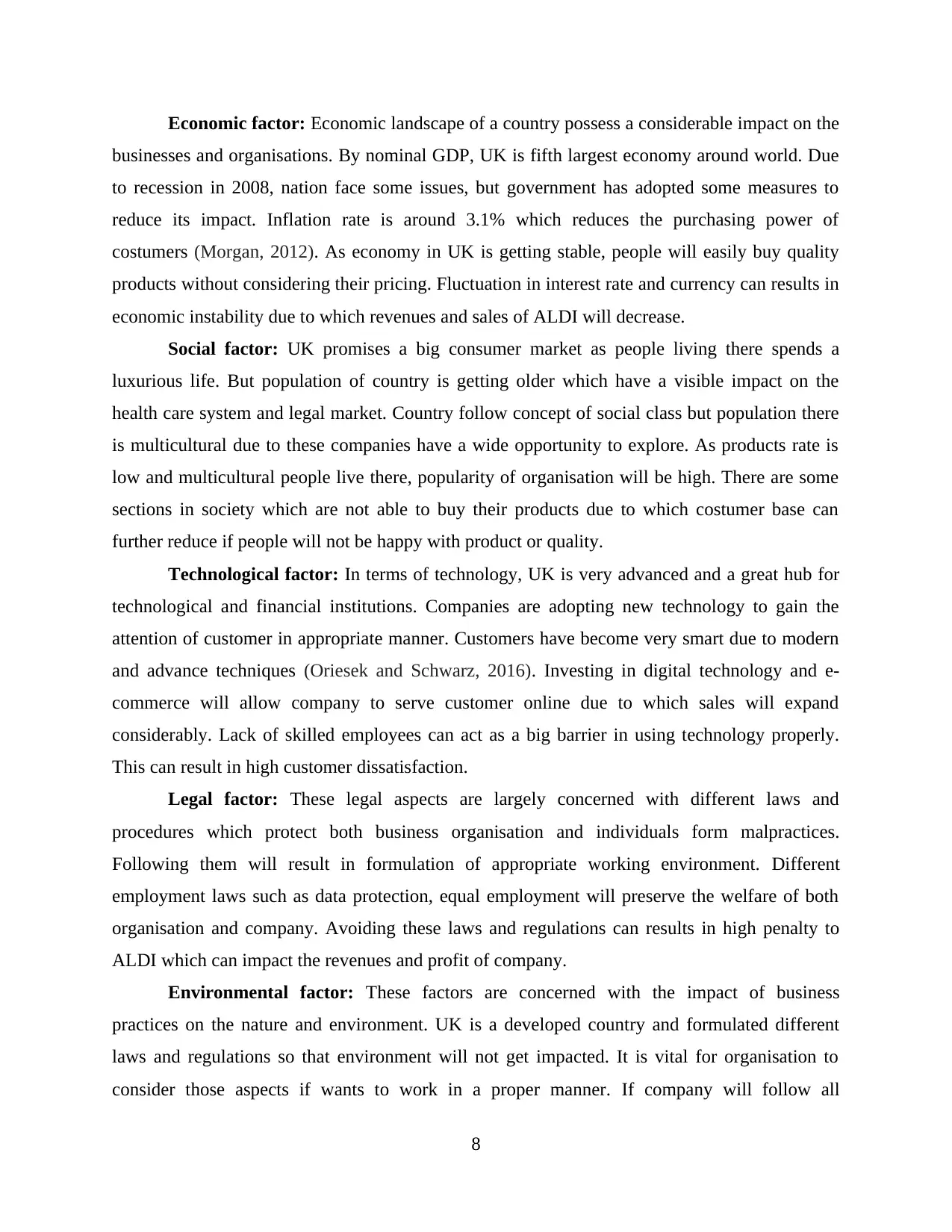
Economic factor: Economic landscape of a country possess a considerable impact on the
businesses and organisations. By nominal GDP, UK is fifth largest economy around world. Due
to recession in 2008, nation face some issues, but government has adopted some measures to
reduce its impact. Inflation rate is around 3.1% which reduces the purchasing power of
costumers (Morgan, 2012). As economy in UK is getting stable, people will easily buy quality
products without considering their pricing. Fluctuation in interest rate and currency can results in
economic instability due to which revenues and sales of ALDI will decrease.
Social factor: UK promises a big consumer market as people living there spends a
luxurious life. But population of country is getting older which have a visible impact on the
health care system and legal market. Country follow concept of social class but population there
is multicultural due to these companies have a wide opportunity to explore. As products rate is
low and multicultural people live there, popularity of organisation will be high. There are some
sections in society which are not able to buy their products due to which costumer base can
further reduce if people will not be happy with product or quality.
Technological factor: In terms of technology, UK is very advanced and a great hub for
technological and financial institutions. Companies are adopting new technology to gain the
attention of customer in appropriate manner. Customers have become very smart due to modern
and advance techniques (Oriesek and Schwarz, 2016). Investing in digital technology and e-
commerce will allow company to serve customer online due to which sales will expand
considerably. Lack of skilled employees can act as a big barrier in using technology properly.
This can result in high customer dissatisfaction.
Legal factor: These legal aspects are largely concerned with different laws and
procedures which protect both business organisation and individuals form malpractices.
Following them will result in formulation of appropriate working environment. Different
employment laws such as data protection, equal employment will preserve the welfare of both
organisation and company. Avoiding these laws and regulations can results in high penalty to
ALDI which can impact the revenues and profit of company.
Environmental factor: These factors are concerned with the impact of business
practices on the nature and environment. UK is a developed country and formulated different
laws and regulations so that environment will not get impacted. It is vital for organisation to
consider those aspects if wants to work in a proper manner. If company will follow all
8
businesses and organisations. By nominal GDP, UK is fifth largest economy around world. Due
to recession in 2008, nation face some issues, but government has adopted some measures to
reduce its impact. Inflation rate is around 3.1% which reduces the purchasing power of
costumers (Morgan, 2012). As economy in UK is getting stable, people will easily buy quality
products without considering their pricing. Fluctuation in interest rate and currency can results in
economic instability due to which revenues and sales of ALDI will decrease.
Social factor: UK promises a big consumer market as people living there spends a
luxurious life. But population of country is getting older which have a visible impact on the
health care system and legal market. Country follow concept of social class but population there
is multicultural due to these companies have a wide opportunity to explore. As products rate is
low and multicultural people live there, popularity of organisation will be high. There are some
sections in society which are not able to buy their products due to which costumer base can
further reduce if people will not be happy with product or quality.
Technological factor: In terms of technology, UK is very advanced and a great hub for
technological and financial institutions. Companies are adopting new technology to gain the
attention of customer in appropriate manner. Customers have become very smart due to modern
and advance techniques (Oriesek and Schwarz, 2016). Investing in digital technology and e-
commerce will allow company to serve customer online due to which sales will expand
considerably. Lack of skilled employees can act as a big barrier in using technology properly.
This can result in high customer dissatisfaction.
Legal factor: These legal aspects are largely concerned with different laws and
procedures which protect both business organisation and individuals form malpractices.
Following them will result in formulation of appropriate working environment. Different
employment laws such as data protection, equal employment will preserve the welfare of both
organisation and company. Avoiding these laws and regulations can results in high penalty to
ALDI which can impact the revenues and profit of company.
Environmental factor: These factors are concerned with the impact of business
practices on the nature and environment. UK is a developed country and formulated different
laws and regulations so that environment will not get impacted. It is vital for organisation to
consider those aspects if wants to work in a proper manner. If company will follow all
8
Paraphrase This Document
Need a fresh take? Get an instant paraphrase of this document with our AI Paraphraser
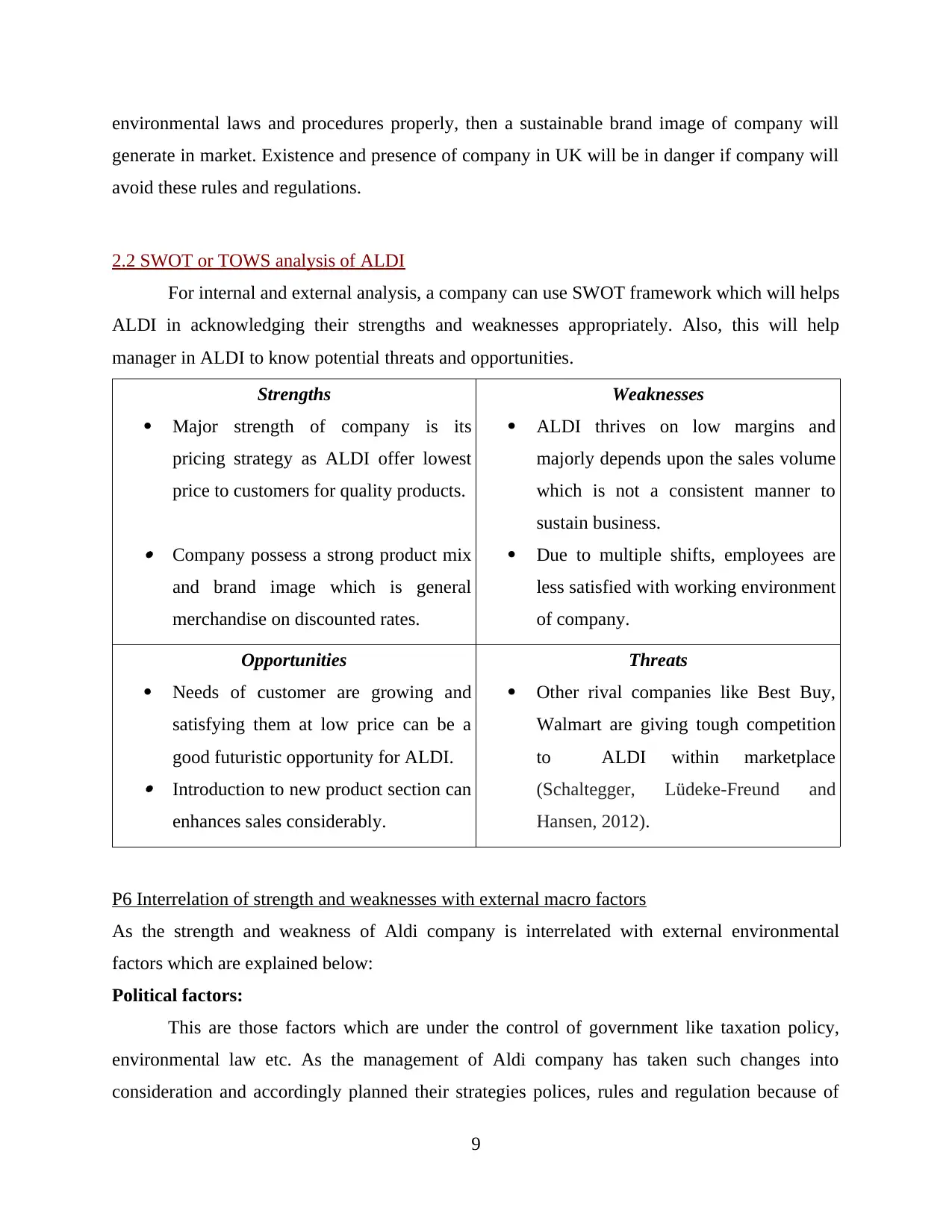
environmental laws and procedures properly, then a sustainable brand image of company will
generate in market. Existence and presence of company in UK will be in danger if company will
avoid these rules and regulations.
2.2 SWOT or TOWS analysis of ALDI
For internal and external analysis, a company can use SWOT framework which will helps
ALDI in acknowledging their strengths and weaknesses appropriately. Also, this will help
manager in ALDI to know potential threats and opportunities.
Strengths
Major strength of company is its
pricing strategy as ALDI offer lowest
price to customers for quality products.
Company possess a strong product mix
and brand image which is general
merchandise on discounted rates.
Weaknesses
ALDI thrives on low margins and
majorly depends upon the sales volume
which is not a consistent manner to
sustain business.
Due to multiple shifts, employees are
less satisfied with working environment
of company.
Opportunities
Needs of customer are growing and
satisfying them at low price can be a
good futuristic opportunity for ALDI. Introduction to new product section can
enhances sales considerably.
Threats
Other rival companies like Best Buy,
Walmart are giving tough competition
to ALDI within marketplace
(Schaltegger, Lüdeke-Freund and
Hansen, 2012).
P6 Interrelation of strength and weaknesses with external macro factors
As the strength and weakness of Aldi company is interrelated with external environmental
factors which are explained below:
Political factors:
This are those factors which are under the control of government like taxation policy,
environmental law etc. As the management of Aldi company has taken such changes into
consideration and accordingly planned their strategies polices, rules and regulation because of
9
generate in market. Existence and presence of company in UK will be in danger if company will
avoid these rules and regulations.
2.2 SWOT or TOWS analysis of ALDI
For internal and external analysis, a company can use SWOT framework which will helps
ALDI in acknowledging their strengths and weaknesses appropriately. Also, this will help
manager in ALDI to know potential threats and opportunities.
Strengths
Major strength of company is its
pricing strategy as ALDI offer lowest
price to customers for quality products.
Company possess a strong product mix
and brand image which is general
merchandise on discounted rates.
Weaknesses
ALDI thrives on low margins and
majorly depends upon the sales volume
which is not a consistent manner to
sustain business.
Due to multiple shifts, employees are
less satisfied with working environment
of company.
Opportunities
Needs of customer are growing and
satisfying them at low price can be a
good futuristic opportunity for ALDI. Introduction to new product section can
enhances sales considerably.
Threats
Other rival companies like Best Buy,
Walmart are giving tough competition
to ALDI within marketplace
(Schaltegger, Lüdeke-Freund and
Hansen, 2012).
P6 Interrelation of strength and weaknesses with external macro factors
As the strength and weakness of Aldi company is interrelated with external environmental
factors which are explained below:
Political factors:
This are those factors which are under the control of government like taxation policy,
environmental law etc. As the management of Aldi company has taken such changes into
consideration and accordingly planned their strategies polices, rules and regulation because of
9
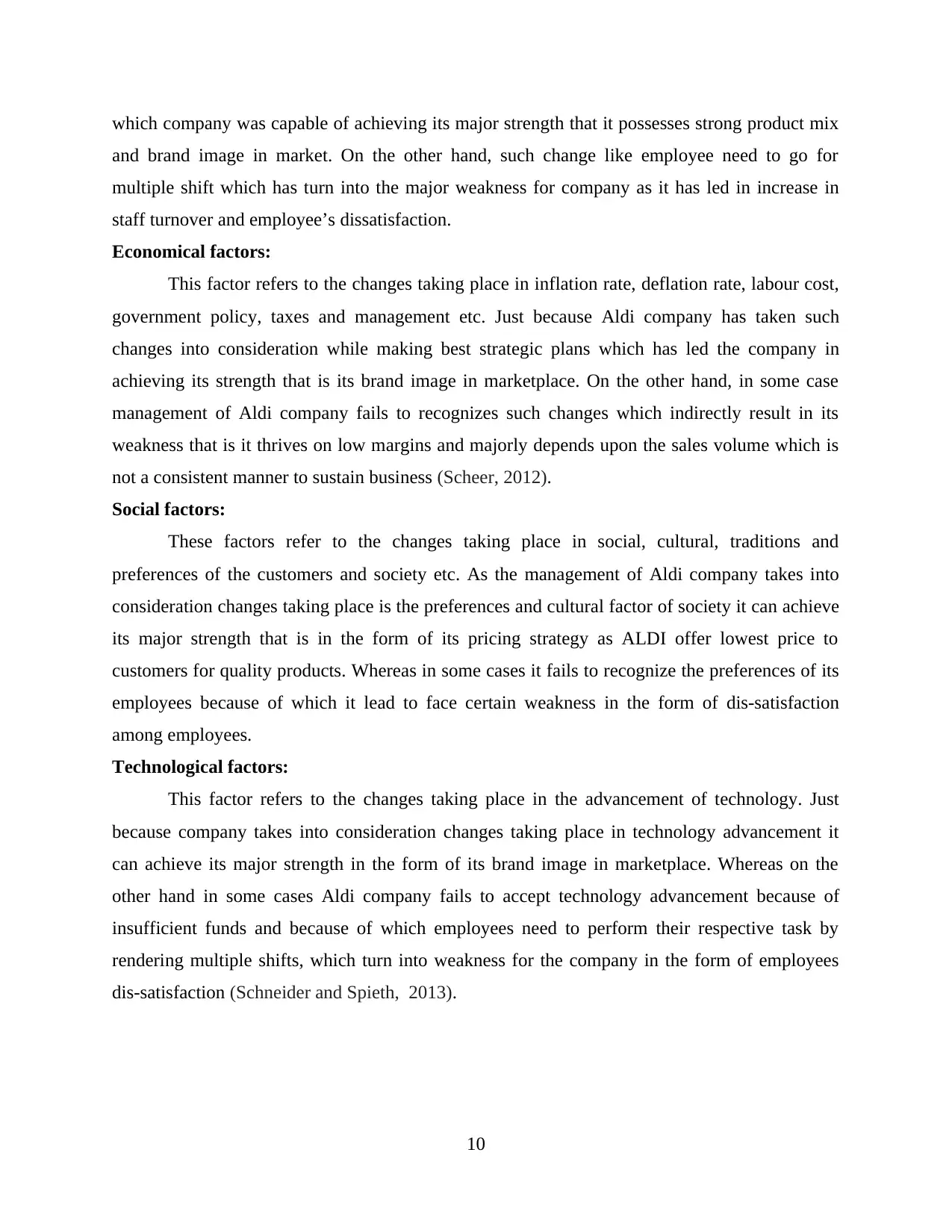
which company was capable of achieving its major strength that it possesses strong product mix
and brand image in market. On the other hand, such change like employee need to go for
multiple shift which has turn into the major weakness for company as it has led in increase in
staff turnover and employee’s dissatisfaction.
Economical factors:
This factor refers to the changes taking place in inflation rate, deflation rate, labour cost,
government policy, taxes and management etc. Just because Aldi company has taken such
changes into consideration while making best strategic plans which has led the company in
achieving its strength that is its brand image in marketplace. On the other hand, in some case
management of Aldi company fails to recognizes such changes which indirectly result in its
weakness that is it thrives on low margins and majorly depends upon the sales volume which is
not a consistent manner to sustain business (Scheer, 2012).
Social factors:
These factors refer to the changes taking place in social, cultural, traditions and
preferences of the customers and society etc. As the management of Aldi company takes into
consideration changes taking place is the preferences and cultural factor of society it can achieve
its major strength that is in the form of its pricing strategy as ALDI offer lowest price to
customers for quality products. Whereas in some cases it fails to recognize the preferences of its
employees because of which it lead to face certain weakness in the form of dis-satisfaction
among employees.
Technological factors:
This factor refers to the changes taking place in the advancement of technology. Just
because company takes into consideration changes taking place in technology advancement it
can achieve its major strength in the form of its brand image in marketplace. Whereas on the
other hand in some cases Aldi company fails to accept technology advancement because of
insufficient funds and because of which employees need to perform their respective task by
rendering multiple shifts, which turn into weakness for the company in the form of employees
dis-satisfaction (Schneider and Spieth, 2013).
10
and brand image in market. On the other hand, such change like employee need to go for
multiple shift which has turn into the major weakness for company as it has led in increase in
staff turnover and employee’s dissatisfaction.
Economical factors:
This factor refers to the changes taking place in inflation rate, deflation rate, labour cost,
government policy, taxes and management etc. Just because Aldi company has taken such
changes into consideration while making best strategic plans which has led the company in
achieving its strength that is its brand image in marketplace. On the other hand, in some case
management of Aldi company fails to recognizes such changes which indirectly result in its
weakness that is it thrives on low margins and majorly depends upon the sales volume which is
not a consistent manner to sustain business (Scheer, 2012).
Social factors:
These factors refer to the changes taking place in social, cultural, traditions and
preferences of the customers and society etc. As the management of Aldi company takes into
consideration changes taking place is the preferences and cultural factor of society it can achieve
its major strength that is in the form of its pricing strategy as ALDI offer lowest price to
customers for quality products. Whereas in some cases it fails to recognize the preferences of its
employees because of which it lead to face certain weakness in the form of dis-satisfaction
among employees.
Technological factors:
This factor refers to the changes taking place in the advancement of technology. Just
because company takes into consideration changes taking place in technology advancement it
can achieve its major strength in the form of its brand image in marketplace. Whereas on the
other hand in some cases Aldi company fails to accept technology advancement because of
insufficient funds and because of which employees need to perform their respective task by
rendering multiple shifts, which turn into weakness for the company in the form of employees
dis-satisfaction (Schneider and Spieth, 2013).
10
⊘ This is a preview!⊘
Do you want full access?
Subscribe today to unlock all pages.

Trusted by 1+ million students worldwide
1 out of 15
Related Documents
Your All-in-One AI-Powered Toolkit for Academic Success.
+13062052269
info@desklib.com
Available 24*7 on WhatsApp / Email
![[object Object]](/_next/static/media/star-bottom.7253800d.svg)
Unlock your academic potential
Copyright © 2020–2025 A2Z Services. All Rights Reserved. Developed and managed by ZUCOL.





